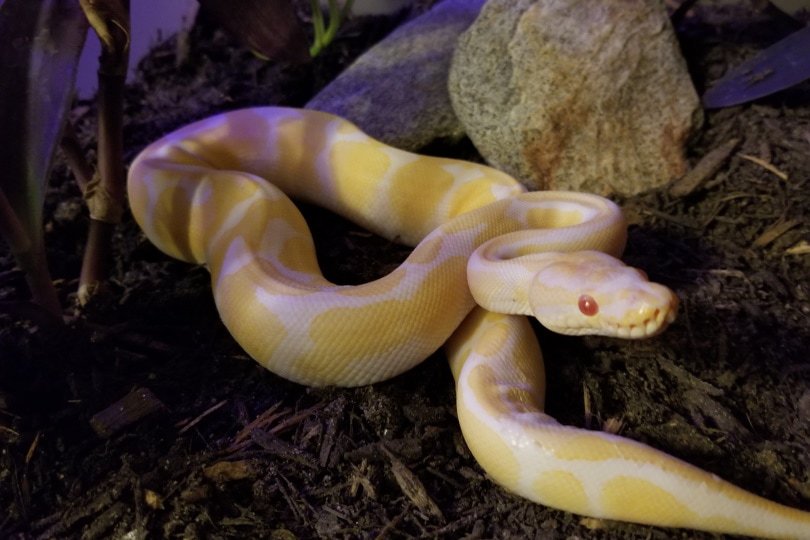The popular Albino Ball Python is one the all time favorite Ball Python color morph!
The Albino Ball Python is a naturally occurring color morph of the Ball Python Python regius. They have been found in their native regions of central and western Africa, yet they are quite rare in the wild. There are actually a number of color and pattern forms that are inherent in the Ball Python. Since the 1990’s, the exciting development of various color forms of the Ball Python have created quite a stir. Of the Boidae family of snakes, the pythons and constrictors, the most extensive color forms discovered and developed have been with the Ball Python Python regius.
The Albino Ball Python is the best known variant of the Ball Python. This classic albino is also referred to as the T-Albino. Those with outstanding colorations are referred to by such names as the Lavender Albino Ball Python, High Contrast Albino Ball Python, Carmel Albino Ball Python, and so on.
It is a gorgeous snake and captive bred specimens have been available for quite a while now. But they are very high in demand and command a very high price. Much of this is due to the breeding habits of the Ball Python. They generally don’t reach sexual maturity until 2 to 3 1/2 years of age, though occasionally one will mature by 18 months. The breeding process is a year long cycle, the eggs are often infertile if proper breeding conditions are not managed, and then they have small clutches, between 4 to 8 eggs. So it takes a long time to produce albino hatchlings.
The Albino Ball Python is a typical Ball Python. It has same great beginner snake qualities and the same behaviors and care requirements as a Ball Python. They are small sized and docile. They, typically reaching 3 to 4 feet (.91 – 1.2 m) in length, though occasionally some reach 5 feet (1.5 m). They typically don’t bite, instead choosing to coil tightly into the ball that gives them their common name. As they grow and are handled, they will become more tame. They make wonderful and beautiful pet reptiles.
- For more information on keeping Snakes see: Guide to a Happy, Healthy Reptile
Albino Corn Snakes
Scientific Classification
| Kingdom: | Animalia |
| Phylum: | Chordata |
| Class: | Reptilia |
| Order: | Squamata |
| Family: | Boidae |
| Genus: | Python |
| Species: | regius |
Scientific Name
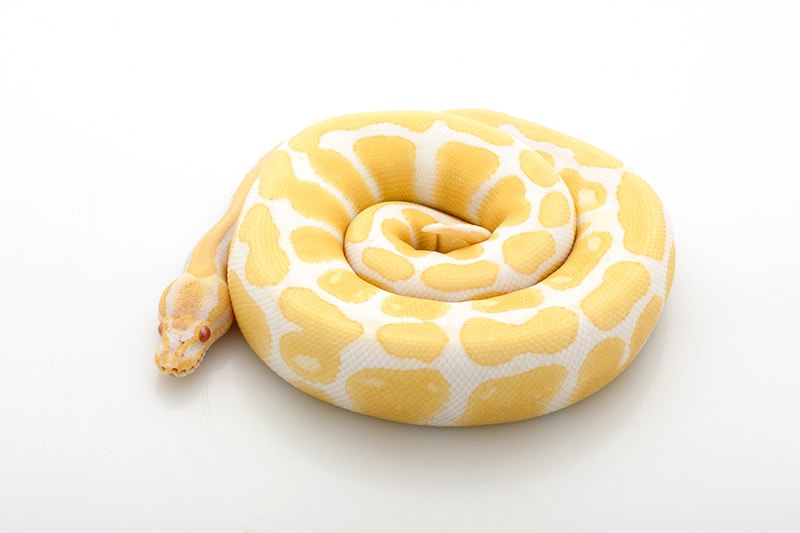
Habitat: Distribution/Background
The Ball Python Python regius was described by Shaw in 1802. They are native to Africa with a wide distribution from Sudan and Uganda in central Africa, and throughout western Africa to Senegal. Tongo, Benin, and Ghana are where the majority of the imported ball pythons are from. They inhabit dry areas, living in both grasslands and open forests, and are also found in agricultural areas.
The Albino Ball Pythons have been found in their native regions of the central and western part of Africa, but they are quite rare. Those available in captivity have been captive bred, with the first breeding reportly by Bob Clark and since then successively through at least three generations.
This classic albino is also referred to as the T-Albino. Those with outstanding colorations are referred to by such names as the Lavender Albino Ball Python, High Contrast Albino Ball Python, Carmel Albino Ball Python, and so on.
Status
The Albino Ball Python is a rare color variant of the Ball Python Python regius. The Ball Python is on the IUCN Red List for Endangered Species as Least Concern (LC).
Description
The Ball Python is the smallest of the African python species. They will grow to between three and five feet (.91 to 1.27 m) with females generally larger than males. Hatchlings usually emerge at 8 to 12″ (20 – 51 cm). They have a robust body with a short tail. They will typically live 20 to 30 years in captivity or longer. One female specimen at the St. Louis Zoo was estimated to have lived more than 55 years.
The classic Albino Ball Python or T-Albino is a simple recessive mutation of Ball Python. It has the normal patterning of the Ball Python, but their coloring is what sets them apart. They are amelanistic (containing no melaninis) which means they lack all dark pigmentation. The ‘pale pattern’ is white and the ‘dark patterning’ is an orange-gold, sometimes seen as a dark yellow in juveniles, getting lighter in adults. They have pink eyes and their tongues are also pink.
Being a wide bodied snake, they use rectilinear movement to crawl forward in a perfectly straight line. This is where they press sections of their body into the ground and then use their muscles to propel them forward.
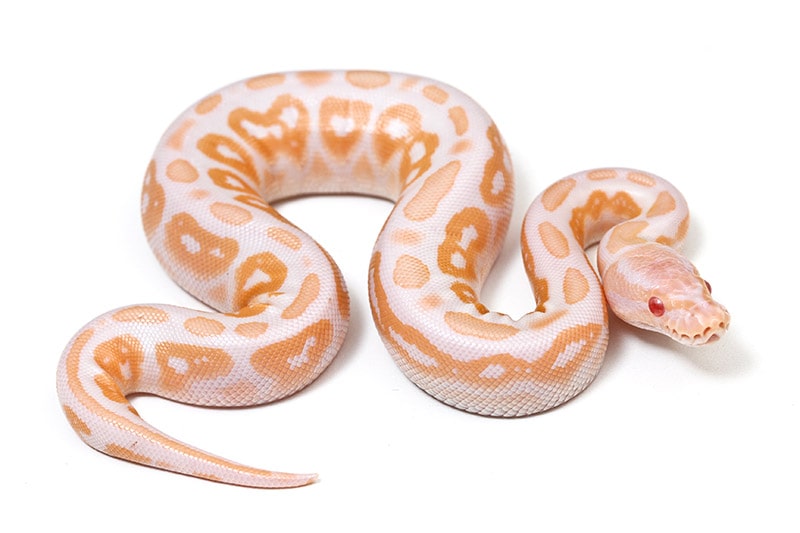
Food and Feeding
Albino Ball Pythons are a constrictor and their diet consists of small rodents. They will eat mice and rats throughout their lives. They are nocturnal, so feed at night. Small Ball Pythons will feed on small “fuzzy” mice (once a week) and will begin to consume larger mice and even small rats as they grow. Adults will feed on adult mice or small rats (one or two every week to ten days).
Ball Pythons will often refuse food if they are handled excessively or when their habitat changes. They will need time to get comfortable in new surroundings.
Fresh water in a good size water dish should always be available. A shallow water dish works well. The python will usually climb in and may get water on the substrate. If this happens, the substrate should be changed or alternatively, the python can be soaked in a separate water dish once a week.
Housing
Ball Pythons are terrestrial snake that inhabits both open forests and grasslands, they can be housed in a woodland-type terrarium with adequate humidity. See terrarium set-ups described under Basic Reptile and Amphibian Care for more information on woodland terrariums.
Adult Albino Ball Pythons require a terrarium that is roughly 36″ long x 18″ wide (91 x 46 cm), or 24″ long x 12″ wide (60 x 30 cm) for a younger python. Hatchling Ball Pythons will thrive in a smaller enclosure approximately 10″ wide and 12″ long (25 x 30 cm), roughly the size of a ten-gallon terrarium.
Young Ball Pythons can be kept on a substrate of paper towel. It is easy to clean, inexpensive, and allows you to closely monitor the enclosure for cleanliness and fecal material. For a more naturalistic setup, you can use cypress mulch and aspen bedding. We do not recommend using newspaper as it is messy and ugly.
A good size water dish will provide a place for soaking and drinking. A heavy limb with plant vining is good for climbing on. One cage accessory that is a must for a Ball Python is the hide box. These are secretive snakes that will spend a great deal of their time hiding. The snake should be allowed to wedge itself tightly into the shelter so it will feel secure. Commercial plastic shelters, clay flowerpots, and a variety of other shelters can be used.
Temperature and Lighting requirements
The Ball Python enclosure should always be large enough to provide the Ball Python with a warm side and a cool side. This can be accomplished best by placing a small heating pad under one corner of the enclosure. The ideal temperature range is 80° to 85 °F during the day and a warmer area that remains in the 88° to 90° F range. They can easily tolerate a drop at night to 75° to 78 °F.
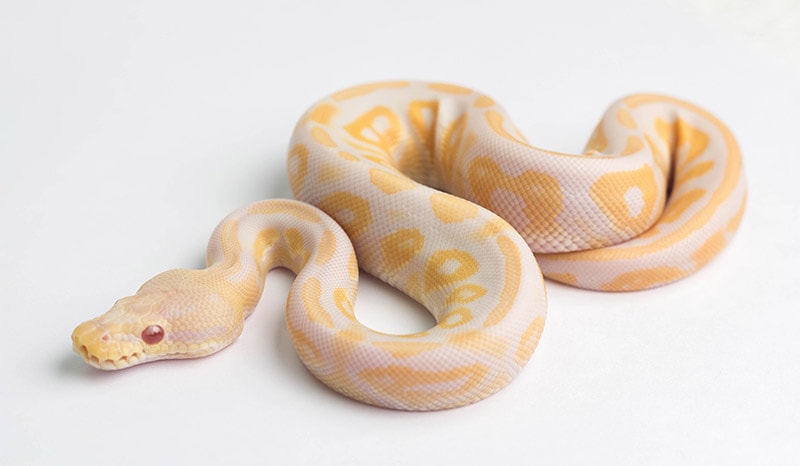
Cage Care
Cage maintenance is an important part of keeping reptiles healthy, and long-lived. Reptiles being kept in a confined area as pets need to be protected from harmful micro-organisms and parasites. The reptile cage needs daily and weekly maintenance. Provide fresh food and water in clean dishes everyday. Check on a daily basis to make sure that the tank is clean. As with any reptile, feces should be removed as soon as they are discovered.
Everything you put into their home should be washed and disinfected weekly. This includes dishes and cage decor. All of the substrate should be changed every three to four months. Never clean with a phenol such as Pine Sol. Chlorine and alcohol based cleaners are tolerated much better, but need to be thoroughly rinsed.
Social Behavior
By nature, Ball Pythons are secretive and spend most of their days hiding in tight-fitting shelters. They are nocturnal so are more active at night. These snakes can be housed alone or in groups with other snakes of similar size and habits.
Handling
Albino Ball Pythons, like all Ball Pythons, can become very tame. However as small babies they are quite secretive and nervous. They will spend most of their time coiled in a tight ball or hiding in their shelters. As they grow (and are held more often by the keeper) they become less timid and will actually begin to explore their enclosure and climb about on the keeper’s hands. (Be careful as they can disappear quite quickly when you run to the kitchen for a drink or take a phone call.)
The Ball Pythons temperament and willingness to be handled makes them an easier snake for children to handle. But children should always be supervise when they are handling them. As with all reptile pets, anyone who handles the reptile should be sure to wash his or her hands after handling their pets.
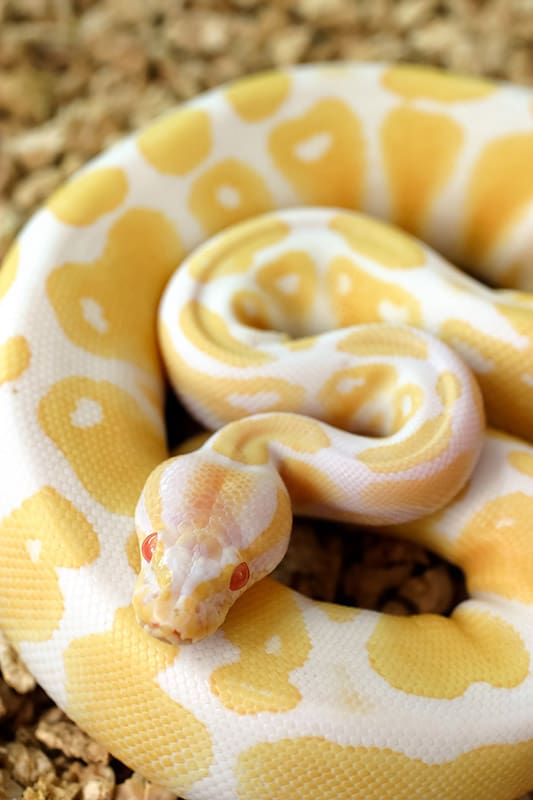
Reproduction
These snakes, if not babies, need to be probe sexed for positive sex identification. They are typically sexually mature between 2 and 3 1/2 years though occasionally a ball python will be mature at about 18 months. A healthy pair of Ball Pythons will usually show interest in breeding at two years of age. (Males usually sooner and females occasionally longer, depending on the feeding schedule.) A sexually mature male is typically a 30 to 36″ (76 – 91 cm) animal, while a female will need to be in the 40″ (102 cm) and 1000 gram+ range. Typically the female is introduced into the male’s enclosure after each snake has been fed well.
They have small clutches, in the 4 to 8 egg range. They will breed in the cool, rainy seasons. In nature, after laying the female then broods the eggs. You can let the female incubate the eggs herself (in a nest box) or you can remove the eggs to be incubated in an incubator. If they are removed, the eggs should be incubated in a mixture of damp vermiculite.
The eggs will hatch in 50 to 60 days at an incubation temperature of 82° to 86° F (28 – 30° C). The hatchlings range from 10″ (25.4 cm) to 17″ (43.2 cm) in length.
Diseases: Ailments/Treatments
As Albino Ball Pythons available to keepers are captive-hatched babies, there are relatively few health concerns as long as they are kept in a proper enclosure and are fed the proper diet. Some illness to be aware of are: Some illness to be aware of are:
Mites and ticks
These small ectoparasites are occasionally seen on pet snakes. They typically arrive with imported pythons or are infested when they are housed at a reptile dealer’s facilities. They should be removed as they feed on blood from the host (your python) and can cause stress and can carry diseases. There are a wide range of products available to keepers for the removal of these parasites.
Respiratory illnesses
Pythons that are kept too cool can get respiratory issues that can be life-threatening. Signs of problems include frequent yawning, gaping, gasping or opening of the mouth, and bubbling from the nose. Seek veterinary help if you see a combination of any of these signs. (A snake will yawn to realign its jaws after feeding. This is a normal behavior.)
Dermal Fungal Infections
If a Ball Python is kept too cool or too humid for an extended period of time, the snake may develop skin lesions that will become crusty and bloody. A keeper should immediately look at his or her enclosure and make sure that the snake is being kept warm and dry enough. Clean the lesions with a gentle wash of Betadine or antibiotic cream until it heals.
“Mouth Rot”
If a snake’s mouth does not shut well or if you see unhealthy exposed gum tissue, this may be a sign of infective stomatitis or “mouth rot”. Healthy gums are a light pinkish white without marks or red veining. Red splotches or other discolored areas may be early signs of “mouth rot”.
Shedding Problems
Stuck sheds, retained eye caps, and other shedding problems are occasionally seen in Ball Pythons. Though the area in which they live is relatively hot and dry, they do spend a great deal of time in burrows, underground, and even in termite nests. These areas are not only warm, but are also humid. So, when a Ball Python is ready to shed (first signs are opacity of the eyes), the humidity within the enclosure or especially under the shelter should be raised. This will allow for proper shedding.
Rodent Bites
Never leave a live feeder rodent in a snake’s enclosure. A freaked out mouse or rat may attack the snake. Though they are great predators, many captive Ball Pythons are attacked by live rodents each year and many of them die horrible deaths. Either remove the rodent if it is not eaten right away or feed your snake pre-killed prey.
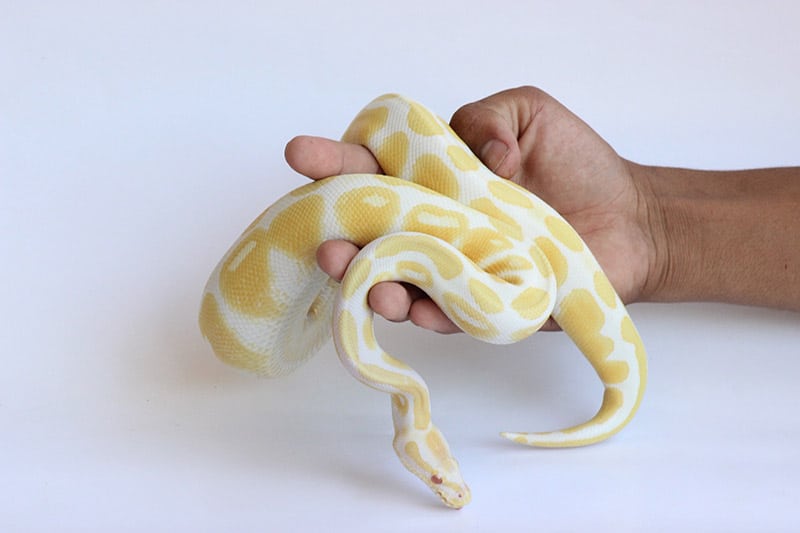
Availability
The Albino Ball Python is in great demand. Because Ball Pythons lay relatively small clutches, their are often more people who want them then are available. Consequently they are expensive, starting at about $2,500 and up. The best place to find these snakes is on-line, or at a reptile show or expo.
Featured Image Credit: Tatem Marie Miley, Shutterstock
